
We carry a range of HSA- and FSA-eligible products, including over-the-counter medications, medical devices and more. And you can have it all delivered to your door.

New parents can choose something basic or get one with all the bells and whistles. Here’s what to consider before you buy.
If you’re expecting, a baby monitor is probably on your must-have list. These devices can offer peace of mind. And there are tons of options. You can buy a monitor that’s high-tech, low-tech or somewhere in between.
Maybe you want to see and hear every movement and sound your baby makes, no matter how slight. Or perhaps you just want something super simple so you can hear when your infant is crying and needs some TLC. Either way, there’s a baby monitor that will meet your needs.
“You can keep your child safe and healthy without a baby monitor,” says Matthew Harris, MD. He’s a pediatric emergency room doctor at Northwell Health Cohen Children’s Medical Center in New Hyde Park, New York. “But parents who want that constant engagement with their infant when the baby is sleeping will find plenty of choices.”
Here are some basics you should know before you choose a model.
A baby monitor gives a new parent the opportunity to bond with their baby, says Dr. Harris. If you live in a large house — or if you commute to an office every day — you might appreciate a monitor with a video screen that allows you to check in easily.
“Parents today are in a different place than they were five years ago,” says Dr. Harris. “They want more constant contact when it comes to their baby, whether they’re in an office or working from home. They may want to be able to switch on a camera and see that their child is resting comfortably.”
If having a baby monitor helps you sleep better at night, you should invest in one, says Drew Johnson, MD. He’s a pediatrician at Banner University Medical Group Cholla Pediatrics in Tucson, Arizona.
Keep in mind, though, that some high-tech devices might make you more nervous. With some monitors the sensors go off frequently, even if nothing is wrong. These false alarms can keep you awake at night, Dr. Johnson points out.
Baby monitors fall into several categories, and they can range in price from less than $20 for a basic audio monitor to more than $300.
Just the basics: Audio-only monitors. These devices are no-frills. They don’t connect to Wi-Fi, and they don’t have a camera. You place one unit in your baby’s room and the other unit wherever you are in the house. When your baby cries, you can hear it through the monitor. Some models have an intercom function so that you can talk (or sing) to your baby from another room. Audio-only monitors work only inside your home.
Next level: Non-Wi-Fi video monitors. These devices are also low-tech, but they include a video monitor so that you can see your baby. Like audio-only devices, they don’t connect to the internet and don’t require Wi-Fi. Because they are not connected to Wi-Fi, you don’t have to worry about software updates or security breaches. On the downside, they work only when the monitor and camera are within range of each other.
High-end: Wi-Fi-connected monitors. With high-end video baby monitors, you get to see your child on your smartphone screen. And you can check on them via a livestream, whether you’re in the next room or across town at your office. Some devices allow you to monitor your baby’s vital signs and see the temperature and noise level of the room.
High-end monitors often have night vision that can send a clear image of your baby even in low light. (One example is the Owlet Cam Smart HD Video Baby Monitor.) And some devices even capture a time-lapse highlight reel of your baby’s entire night, which you can watch quickly the next morning (Nanit Pro Smart Baby Monitor and Floor Stand).
On the downside, Wi-Fi-connected monitors aren’t as reliable if the Wi-Fi in your home is weak.
Shop for baby monitors and other new-mom essentials at the Optum Store, and have products shipped directly to your front door.
What type of monitor you buy really depends on your personal preferences. You should buy the one that feels right for you and fits your budget.
Dr. Harris recalls a time when his baby had bronchiolitis (a common lung infection in infants and young children). He found it reassuring, he says, to be able to check a high-tech baby monitor and keep an eye on his baby’s heart rate and average oxygen level.
But parents should not rely on these numbers too heavily, he cautions. “Too much information can be concerning for a parent,” he says. “The monitors that give the heart rate and the oxygen level can give false readings if they are not applied properly, so it’s very important to follow the directions.”
Dr. Johnson says he prefers baby monitors with “fewer bells and whistles.” But he does like the ones that monitor the temperature of the baby’s room and provide night vision, which will help you see your baby in a dark room.
No matter what type of baby monitor you choose, it is vital that you put your infant to sleep safely for naps and at bedtime. Until their first birthday, babies should always be put to sleep on their back, according to the American Academy of Pediatrics (AAP). Babies who sleep on their back are much less likely to die of sudden infant death syndrome than those who sleep on their side or stomach. Other safe sleep tips from the AAP:
As your child grows, you may wonder how long you should keep using the baby monitor. Some parents keep using them even when their kids are toddlers or preschoolers.
“For older kids, a baby monitor can be more like a security camera,” Dr. Harris says. You can check to see whether they are in bed or if they’re trying to climb out of their crib.
Dr. Johnson recommends that parents consider retiring the baby monitor when their child is 4 or 5. “By this age, many kids are starting to get a sense of privacy and want to have their own space,” he says.

We carry a range of HSA- and FSA-eligible products, including over-the-counter medications, medical devices and more. And you can have it all delivered to your door.
Additional source
Sleep safety: American Academy of Pediatrics (n.d.). “Tips for Keeping Infants Safe During Sleep from the American Academy of Pediatrics”